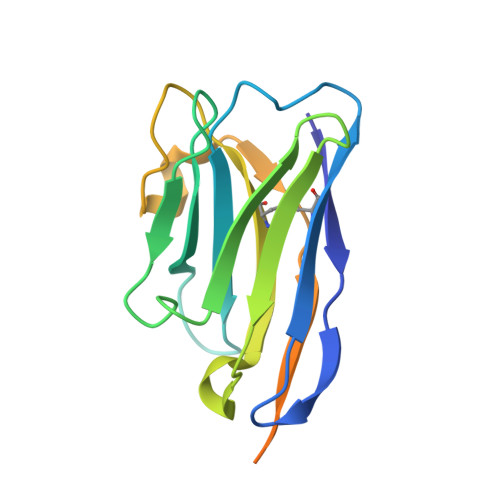Immuno-targeting the multifunctional CD38 using nanobody
Li, T., Qi, S., Unger, M., Hou, Y.N., Deng, Q.W., Liu, J., Lam, C.M., Wang, X.W., Xin, D., Zhang, P., Koch-Nolte, F., Hao, Q., Zhang, H., Lee, H.C., Zhao, Y.J.(2016) Sci Rep 6: 27055-27055
- PubMed: 27251573
- DOI: https://doi.org/10.1038/srep27055
- Primary Citation of Related Structures:
5F1K, 5F1O, 5F21 - PubMed Abstract:
CD38, as a cell surface antigen is highly expressed in several hematologic malignancies including multiple myeloma (MM) and has been proven to be a good target for immunotherapy of the disease. CD38 is also a signaling enzyme responsible for the metabolism of two novel calcium messenger molecules. To be able to target this multifunctional protein, we generated a series of nanobodies against CD38 with high affinities. Crystal structures of the complexes of CD38 with the nanobodies were solved, identifying three separate epitopes on the carboxyl domain. Chromobodies, engineered by tagging the nanobody with fluorescence proteins, provide fast, simple and versatile tools for quantifying CD38 expression. Results confirmed that CD38 was highly expressed in malignant MM cells compared with normal white blood cells. The immunotoxin constructed by splicing the nanobody with a bacterial toxin, PE38 shows highly selective cytotoxicity against patient-derived MM cells as well as the cell lines, with half maximal effective concentration reaching as low as 10(-11) molar. The effectiveness of the immunotoxin can be further increased by stimulating CD38 expression using retinoid acid. These results set the stage for the development of clinical therapeutics as well as diagnostic screening for myeloma.
Organizational Affiliation:
School of Chemical Biology and Biotechnology, Peking University Shenzhen Graduate School, Shenzhen 518055, China.















